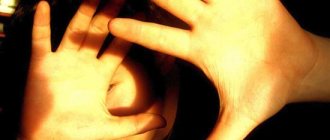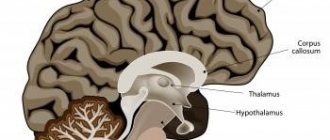Methodology for performing the Barre test
In many ways, balance testing depends on what kind of deviation is being diagnosed. In order for the patient to take the correct position, he needs to stand straight, with his legs pressed tightly against each other.
Next, the patient should stretch his arms in front of him and close his eyes. But test variants are possible when the eyes are closed, but the arms remain in a lowered position along the body. In this situation, the doctor must support the patient, preventing falls and injuries.
If we talk about the sphere of neurological abnormalities, then with this position any staggering is taken into account and the main task of checking the Romberg symptom is to determine the degree of stability. Time intervals are also taken into account, which are also important for correct diagnosis.
In this position, the patient should extend his arms in front of him and close his eyes. An option is possible in which the head is thrown back.
In many ways, balance testing depends on what kind of deviation is being diagnosed. In order for the patient to take the correct position, he needs to stand straight, with his legs pressed tightly against each other.
Quite often, the Romberg test is taken at home, in no case to establish a diagnosis, but rather as proof that everything is fine with the person. Sometimes, with the help of such home testing, you can identify the problem, if any, in time and seek help from specialists.
If such a test is carried out at home, there must be another person present who can provide protection and prevent a possible fall. When a person is confident in his health and strength, he can use a more complicated version of the pose, which will allow him to more accurately assess his state of health.
There are approximate time data for which a person must stand in this position. If we talk about young people, it is considered normal for them to stand in this position for 30 seconds, but here it is worth taking into account the person’s physical fitness.
Sports play a significant role; if a person is physically developed and plays sports, the result of 30 seconds is absolutely normal for him. When a person leads a passive lifestyle and does not exercise, the time interval can be reduced.
If there are obvious deviations during the procedure, you should definitely contact a specialist. Since the disease detected in time is much faster to treat than advanced forms. In addition, it is worth remembering that any disease can cause complications and bring many more complications.
The most important thing is to provide the diagnosis to a specialist, and not to diagnose yourself. In such situations, it is unacceptable to take medications based on self-conducted tests.
The inability to stand evenly, steadily and without swaying with a straight spine and closed eyes is called Romberg's symptom or pose; it is unstable in those who have problems with the nervous system.
The legs should be tightly pressed together, the spine line should be extended upward, the shoulders and chest should be open, and the arms should be straight out in front of the body, the hands should be located no lower than the line of the shoulder joints.
With their eyes closed, some people cannot maintain a stable position: they begin to sway, their hands may begin to shake, and they may feel like they are leaning back. In some cases, instability in the Romberg position is additionally checked by asking the person being tested to place one foot in front of the other so that the heel of the front foot touches the toes of the back foot.
The lower test is carried out using two techniques: lying on your back and lying on your stomach. This method is also carried out with eyes closed. The specialist asks the patient to raise his legs 50 degrees from the ground and hold them in this position. Here it is important to determine either the weakness of one leg or the general weakness of both legs, as well as the inability to hold the legs at all.
For complete differentiation, you can help the patient by holding his legs with his hand. The leg that is paretic will put more pressure on the arm.
The upper Barre test is carried out as follows: the patient should extend his arms forward, palms. After such movements, he closes his eyes and holds his hands for thirty to forty seconds.
With minor deviations, a weak hand may simply be slightly off. With more significant paresis, the affected arm bends at the elbow.
Read: What functions do the colorless organelles leukoplasts perform and their structural features
The Romberg test is performed by the patient in a standing position, arms extended forward, fingers slightly apart. The subject first stands for some time with his eyes open, then his stability is assessed in the absence of visual control over balance, for which he is asked to close his eyes.
During this test, the doctor must be nearby to prevent the patient from falling if he loses his balance.
In neurology, it is customary to classify this exercise by degree of difficulty. According to this criterion, there are three varieties of the Romberg pose. The position of the hands in each of these positions remains unchanged, the pose becomes more complicated by changing the position of the legs:
- 1. Simple - feet pressed tightly against each other.
- 2. Complicated - the feet are placed in one line (as if a person is walking on a tightrope): the toes of one foot are pressed to the heel of the other.
- 3. The most difficult one is that the patient stands on one leg (to reduce the area of the fulcrum), and the tucked foot is pressed against the knee of the supporting limb.
We recommend
Ataxia: main signs and types, causes of the disease, treatment
The doctor, observing the patient, evaluates the following characteristics of the test:
- stability - the patient stands confidently or staggers, if swaying appears - after what period of time this happened;
- the direction of the patient’s deviation in case of instability - it matters in which direction the person “falls”: to the right, left or back;
- does ataxia (staggering) worsen when closing the eyes;
- whether there is tremor of the fingers, arms, legs or torso, or trembling of the eyelids.
When staggering occurs, the test is considered positive. If the doctor interprets the result as a “negative Romberg test,” this means that no pathology has been identified.
| Age, years | Duration of maintaining balance, seconds |
| 7 | 16 |
| 8 | 21 |
| 9 | 24 |
| 10 | 28 |
| 11 | 30 |
| 12 | 36 |
| 13 | 44 |
| 14 | 48 |
| 15 | 50 |
| 16 | 51 |
| 17 | 52 |
| 18 | 53 |
We recommend
List of medications for the treatment of epilepsy
While watching a patient perform the Romberg test, an outside physician must evaluate several important parameters.
- Stability in the Romberg pose - how confidently a person stands, after what time swaying appears.
- The doctor must notice where the patient’s body deviates, back or forward, to the right or to the left, the diagnostic result depends on this.
- It is assessed what happens when the patient closes his eyes, whether instability increases. Do the patient’s fingers, toes, or eyelids tremble while performing the exercise?
- Staggering while performing the classic Romberg test with eyes open indicates problems in the cerebellum. The direction of the body deviation indicates which part of the cerebellum needs treatment.
- Staggering with both open and closed eyes may be a consequence of problems with the cerebral cortex. In this case, the patient will fall to the side opposite the affected side of the brain.
- Disturbances in the functioning of the inner ear, the main organ responsible for the human vestibular apparatus, can cause a fall when performing the Romberg exercise.
- Problems in the functioning of muscles and joints are diagnosed when rocking while closing the eyes. Such deviations may be concomitant signs of diabetes mellitus.
- Rocking from side to side, without falling, occurs in the presence of diseases such as VSD syndrome, neuroses. An experienced doctor will be able to distinguish this type of deviation with the help of additional distracting tests.
If the Romberg test result is negative, the hands should remain motionless. Involuntary movements of the limbs may indicate various disorders of the central nervous system. Hand tremor in the Romberg position is an alarming symptom; it can be a sign of a variety of diseases:
- Parkinson's disease;
- cerebellar pathologies;
- essential tremor;
- diseases of the extrapyramidal system.
The Romberg test is divided into simple and complex, and in each exercise the results will differ from the previous ones.
The first execution option is for the subject to stand with full support on two legs, with eyes closed and arms outstretched with fingers slightly apart. During research, attention is paid to the duration of stay in a given state, as well as any swaying or voluntary movements of the person.
How testing is carried out
In many ways, balance testing depends on what kind of deviation is being diagnosed. In order for the patient to take
correct posture, he needs to stand straight, while his legs should be pressed tightly against each other.
Next, the patient should stretch his arms in front of him and close his eyes. But test variants are possible when the eyes are closed, but the arms remain in a lowered position along the body. In this situation, the doctor must support the patient, preventing falls and injuries.
If we talk about the sphere of neurological abnormalities, then with this position any staggering is taken into account and the main task of checking the Romberg symptom is to determine the degree of stability. Time intervals are also taken into account, which are also important for correct diagnosis.
A more difficult version of the test involves placing your legs so that they are on the same line. This happens as follows: the patient places his feet so that the heel (for example, the right foot) is in contact with the toes (of the left foot) and they are on the same line.
In this position, the patient should extend his arms in front of him and close his eyes. An option is possible in which the head is thrown back.
Putting the body in order
First of all, this is necessary for city residents who need mental and physical training to improve the general condition of the body and increase performance. Physical training brings into play previously dormant corners of the whole body, revitalizing them and improving biochemical processes. Breathing becomes more uniform and, as a result, gas exchange normalizes.
A properly designed set of physical exercises improves physical, biochemical and even nervous processes in the body. If they work harmoniously, then the body responds faster to impulses sent by muscles, joints, vestibular apparatus and other body systems. Therefore, one can talk about the benefits of therapeutic and preventive gymnastics for hours.
Romberg's symptoms
If the use of the Romberg pose does not give a clear positive or negative answer, then the patient is asked to complicate it. To do this, place your feet along a straight line, so that the toe of one foot is pressed tightly against the heel of the other. If, in such a position, swaying or pushing of the body in different directions is already noticeable, then this is a consequence of the development of ataxia.
Symptoms according to Romberg appear if there are disturbances in the functioning of the cerebellum, as well as its relationship with other parts of the brain and in case of a disorder of the vestibular apparatus, impaired sensitivity due to damage to the spinal cord, or with polyneuritis. It is important to determine the direction in which the patient is staggering, since most often this has diagnostic significance. If there is a disease of the cerebellum, then the patient leans towards the affected hemisphere.
It is also necessary to take into account the fact that rocking in the Romberg position indicates not only neurological diseases, it may indicate the presence of neuroses.
The cerebellum in the human body is responsible for orientation in space. Its neurons instantly respond to sent impulses that are responsible for changes in the environment or changing tasks. If cerebellar damage occurs at an early age, when the child has not learned motor skills, then learning movements will be extremely difficult.
If the defeat occurs when the necessary motor skills have been acquired, then the performance of already known exercises will occur with significant impairments. Deviations may be observed in relation to the trunk, as well as the limbs. The Romberg pose is suitable for identifying these violations. Ataxia is a consequence of a violation of the proper functioning of the cerebellum.
The main indicator of cerebellar dysfunction is the development of symptoms such as:
- cerebellar ataxia;
- muscle atony;
- asynergy.
The vestibular test in the Romberg position helps to identify ataxia. These disorders are accompanied by severe dizziness, vomiting and nausea.
With muscle atony, the patient's range of joint motion increases, the muscles become flabby and sluggish, and because of this, it is difficult for the patient to perform any physical exercises, and sometimes even just move.
It is important to note that it is impossible to speak unequivocally about a disease of the central nervous system just by relying on this study. Since the Romberg pose is the simplest method that can only suggest diseases of the central nervous system in the early stages. If deviations are observed when performing this method, then it is worth conducting an additional full medical examination.
Cerebellar ataxia is deviations from the correct execution of any movements and decreased coordination. From the outside, such movements may be regarded as unstable, clumsy or sloppy. They seem completely unrelated. In this case, ataxia can affect absolutely any part of the body.
When coordination of various muscle groups involved in individual movements is impaired, a symptom such as asynergia develops. For example, with normal movement of the limbs, the patient cannot crawl on all fours, because he does not understand how to coordinate the alternate movement of arms and legs.
Romberg test results
It is not only the ability to be in this position that matters, but also endurance. A physically developed person can stand without swaying for about 30 seconds. The lower limit of normal for an adult is 6 seconds. If there are any deviations, you should immediately consult a neurologist for further instrumental and other examinations.
Holding a pose for less than 8 seconds may indicate that there are some problems with the motor neurons, the motor areas of the cerebral cortex. Cerebellar atrophy and disorders in the functioning of the vestibular apparatus lead to gross disturbances and increased instability. Children with such pathologies may experience delayed physical development, poor academic performance, and mental illness. Often people in this case are assigned a certain disability group, incapacity for work.
All about diagnosing spinal cord and brain tumors using non-invasive methods.
Information about the causes of increased eye pressure, diagnosis and treatment approaches.
It is recommended to read how to identify dyscirculatory encephalopathy by its characteristic symptoms.
This test can be performed independently, but no result will give an accurate idea of the likely diagnosis. Additional examinations are required, which are prescribed by a neurologist:
- Electroencephalography, MRI of the brain, ultrasound.
- Vascular examination - Doppler ultrasound.
- General blood test, determination of the content of narcotic substances, alcohol, medications.
- If inflammatory diseases are suspected, a spinal puncture is performed to collect cerebrospinal fluid for analysis.
- Myelography is prescribed for back injuries if there are neurological disorders (changes in tendon reflexes).
Evaluation of results
Normally, an adult should maintain stable balance for at least 15 seconds, equally well with open and closed eyes, trembling and other involuntary movements are not observed.
Unsteadiness in the Romberg position or the presence of tremor may indicate the presence of some disease, therefore, if deviations from the norm are detected, a thorough further examination is required.
Various involuntary movements of the hands in the Romberg position can be observed with pathologies of the cerebellum, and the appearance of tremors can be a sign of the development of diseases of the extrapyramidal system, for example, Parkinson's disease or essential tremor.
Confident execution of the Romberg exercise gives the doctor the right to make an entry in the patient’s card that he is healthy. The main symptom of abnormalities in the functioning of the nervous system is staggering during testing. People who care about their health should be concerned with the question: if a person is unstable in the Romberg pose, what does this mean?
The Romberg pose in neurology, in addition to determining dysfunction of the cerebellum and cerebral hemispheres, gives an assessment of a person’s physical fitness (there are tables and photos):
- if the pose is maintained for more than 15 seconds without tremor, the person is healthy, this is the norm for stability;
- there is a staggering of the body - the indicator is satisfactory;
- holding a pose for less than 15 seconds – unsatisfactory stability;
- the presence of tremor in the patient’s limbs is an indicator of body disorders.
The complicated Romberg pose is performed so that the subject’s feet are on the same line, for example, when the toes of the left foot are adjacent to the heel of the right and vice versa. The subject stretches his arms forward, sometimes throwing his head back.
The neurologist observing the patient perform the test must protect him from accidental falls due to staggering.
A positive Romberg test may mean alcohol or drug intoxication, the effect of psychotropic drugs, mental illness or malingering, or inappropriate behavior of the person being tested.
First, the pose is performed in a simplified version, i.e. when the arms are along the body and the legs are together, and the patient’s eyes are closed. If this is successful, the test becomes more complicated, the legs are placed toe to heel of opposite legs, the arms are extended forward.
This test is easy to perform and can be used at home. However, if the subject already has cerebellar signs (unsteadiness of gait, incoordination of motor acts, nystagmus, tremor), it is necessary to carefully monitor the person so that he does not fall.
What does stagger mean?
Different parts of the nervous system are responsible for how much a person is able to maintain balance in a given position. If, when checking the Romberg pose, loss of balance, staggering, swaying or deviation to the side is observed, then this means that a neurological disease is present.
Situations are possible when the patient loses his balance during the diagnostic process and leans to one side. Such a deviation may indicate a possible lesion of the cerebellar hemisphere, and the side on which the patient fell is taken into account, which indicates precisely the side of the lesion.
Situations are also possible when a person leans back or falls; such a manifestation may indicate possible mental illnesses. But simulation by the patient is also possible, since such behavior is more related to the mental state.
In order to avoid misdiagnosis, doctors who conduct diagnostics pay attention to the patellar muscles.
The difference between a healthy and a sick patient is that when a fall occurs in the presence of a disease, the patient tries to stand, thereby straining the muscles and the kneecaps rise. In cases where simulation occurs, the patient does not tense his muscles, as he does not show any attempts to stand.
If the posture is unstable: what does this mean?
Immediately make sure that the entire procedure is carried out in a calm environment, without external stimuli, and if there is staggering in the Romberg position, loss of orientation in space, or even a fall within a short period of time (less than eight seconds), then you need to sound the alarm: along with the untrained vestibular apparatus Most likely, the posterior nerve roots of the spinal column, which are responsible for the conduction of nerve impulses, are damaged, multiple atherosclerosis is possible (especially if maintaining a posture is impossible even with open eyes), although perhaps this is just a tendency to neurasthenia, neuroses and inability to control functions bodies.
If the cerebellum is affected, the patient will deviate towards the affected side, because the cerebellum is responsible for the coordination of movements, which a person comprehends in childhood. If the Romberg position is held, but not for long, then most likely there is only a tendency to atrophy of the skeletal muscles: this can be corrected if you practice this position every day until a stable result is obtained.
What is the Romberg pose: concept and reasons. Romberg's pose: photo. Instability in the Romberg position
The human body is designed in such a way that if one system fails, the rest will follow. The most important human system is, of course, the nervous system, along with the spine, along which the most important “transmission line” runs.
As long as a person actively and variedly uses the small muscles of the whole body, his nervous system works flawlessly, but if a passive and sedentary lifestyle overcomes common sense, then health problems begin: immediately minor in the form of headaches or chronic fatigue, but over time the problem gets worse health will grow like a snowball, and one day it will result in a serious illness.
If you try to regularly perform the Romberg pose, the body, learning to stretch and correct the maintenance of balance in space, will use different and varied neural circuits, thus maintaining the central nervous system in a healthy state.
Training with Romberg pose
Romberg pose - what is it for a healthy person? This is an indicator of the condition of the entire organism as a whole. Correct positioning in this pose is a state that a normal, healthy body should have.
This is exactly the posture that any person should have in his youth, when his muscles are still in good shape. Unfortunately, after a hard day at work, as well as with age, it becomes more difficult for the muscles to keep the body in the correct position, and this requires some effort. In order to help the body cope with the load placed on it, it is necessary to constantly train it.
How to do Romberg pose?
There are two options for researching the name of Heinrich Romberg. First, the patient is offered a classic pose. If no violations are detected during its execution, the position of the body changes. The doctor observes the complicated version, assessing how long the person will stand without moving. The minimum time spent in the Romberg pose for a child is 15 seconds, for an adult the numbers are higher, so the norm for the Romberg pose is at least 1 minute. It’s easy for a healthy person to do it:
- You need to stand straight with your heels together and your toes slightly apart.
- Stretch your arms in front of you, turn your palms towards the floor, spread your fingers.
- Close your eyes. In this position, the doctor assesses the patient’s condition and, if necessary, records deviations from the norm.
The absence of deviations in the functioning of the human nervous system is shown by a negative Romberg test. A complicated version of the study looks the same as the classic pose, only the position of the patient’s legs changes. In this case, the legs are placed one in front of the other, the heel of one is placed against the toe of the other, as if a person is walking on a tightrope.
Yogic version
In the arsenal of yoga poses there is a similar position: Tadasana is a mountain pose, in some schools of yoga it is called Samastitihi, which means “to stand straight and calm.” This is the basic position from which the lesson begins, a test for the stability of the mind and the body’s reaction to it. Some beginners consider this pose uninteresting and insignificant due to its apparent simplicity, and only over the years they understand its real taste and importance, because yoga is not a beautiful or spectacular body position, like legs behind the head, but the ability to keep your mind in check ( “Yuj”, the word from which the term “yoga” comes from, translated from Sanskrit means bridle, harness), remaining even and calm in any situation.
In the arsenal of yoga poses there is a similar position: Tadasana is a mountain pose, in some schools of yoga it is called Samastitihi, which means “to stand straight and calm.” This is the basic position from which the lesson begins, a test for the stability of the mind and the body’s reaction to it. Some beginners consider this pose uninteresting and insignificant due to its apparent simplicity, and only over the years they understand its real taste and importance, because yoga is not a beautiful or spectacular body position, like legs behind the head, but the ability to keep your mind in check ( “Yuj”, the word from which the term “yoga” comes from, translated from Sanskrit means bridle, harness), remaining even and calm in any situation.
How to achieve sustainability?
Try to practice this position for at least five minutes every day, after first checking the correctness of the Romberg pose with the photo above. It is very convenient to do this in front of a mirror, positioning yourself sideways to it, to make sure that the spine is straight and the arms are positioned correctly.
You should try to stretch the crown of your head upward, keeping your spine in one straight line. Pay more attention to the internal tone in the pelvic area: this is where the stability of the entire position comes from, while the pose should not be overly tense and compressed like a spring, it is rather easy composure and concentration.
At first, perhaps, the pose will be difficult and there will be no long-term fixation, or the body will sway or tremble in some areas, but as you get used to it and experience in practice, everything will definitely work out!
Try to practice this position for at least five minutes every day, after first checking the correctness of the Romberg pose with the photo above. It is very convenient to do this in front of a mirror, positioning yourself sideways to it, to make sure that the spine is straight and the arms are positioned correctly.
What is the diagnosis?
The main objective of the Romberg test is to determine dysfunctions of the organs that are responsible for balance. The systems that are responsible for human balance include:
- vestibular apparatus;
- proprioception system;
- brain functions.
Initially, there was only one version of the Romberg pose; now different versions are used. Stopwatches are also used in diagnostics, which allow you to obtain a quantitative assessment of the result.
With this technique, the patient closes his eyes, which allows him to determine how great the influence of vision is in maintaining balance, and how well other organs cope with this function.
How is the medical examination carried out? Romberg pose, Taschen test and a little spice
That means I’m standing in Romberg’s pose... And the doctors are observing and recording
The procedure was not very pleasant: when the pressure was measured, it turned out to be elevated - nervousness took its toll.
Although the situation in the drug examination room is not scary and resembles a general practitioner’s waiting room: a couch and a couple of tables.
Where are the miracle devices that help drivers get clean water?
An addiction specialist evaluates gait, speech and reaction to simple questions and requests.
note
It is clear that a trained eye can identify a drunk or drug addict almost instantly (I hope it is noticeable that I am a positive character?), while the subjective opinion of a doctor is by no means proof of anything.
They offer me to sit on the couch. A few standard medical questions. When was the last time you drank alcohol? It seems like a week ago. Did you use drugs? No. Do you suffer from chronic diseases? AIDS? Diabetes? All responses are recorded in a report. They measure blood pressure (high, damn...)
Then some standardized tests. Romberg pose is when you stand straight, feet pressed together, eyes closed, arms extended straight, fingers spread.
It’s difficult to stay sober here.
“It happens that they just get into the Romberg position and immediately fall,” comments the narcologist. But I’m okay, I’m holding on.
The task becomes more complicated: now you need to touch the tip of the nose with your finger - a similar test is used by psychiatrists during examination. It's called the finger-nose test. This is followed by another Taschen test - you make a revolution around the vertical axis five times, and then look at the pen that the expert moves in front of his nose. Based on eye movements, he also draws certain conclusions and writes them down in a report.
“Look out the window... Now close your eyes... Look at me...” - this already tests the reaction of the pupil to light: some drugs make it inhibited, and sometimes the pupils do not react or react differently.
Then it comes to the breathalyzer, which, naturally, must be included in the register of measuring instruments and verified.
In fact, the same device is used by traffic police officers during the initial examination, except that it works in more comfortable conditions in terms of temperature and humidity.
You need to blow hard and for a long time, so hopes of blowing somewhere past are naive. The measurement is taken when you blow so hard that your ears become blocked.
My breathalyzer showed honest zeros, no clinical signs of intoxication were detected, so at the end of the medical examination report a laconic inscription appears - no intoxication has been established.
Yes, and there is no protocol, because after all, it was journalistic curiosity that brought me to the medical examination, and not the traffic police officers (by the way, they are already standing at the door with the next candidate).
However, even if the breathalyzer shows zero the first time, but the doctor finds clinical signs of intoxication, a urine test is performed to determine the content of prohibited drugs.
These include all drugs and a fair amount of medications.
The study is done in a laboratory, with chemists determining the content of specific substances and comparing them with a list of drugs that prevent driving a car.
Video recording of urination
By the way, to prevent urine changes, video cameras are installed in the toilet - doctors emphasize that this is in accordance with Order No. 289 of 10/05/98. If the suspect tries to cheat, this is also noted.
What drugs are prohibited from being taken before driving? The list of them is large, but there is no single document in which they would be summarized. Since synthetic drugs (spice, salts, etc.) have become widespread, more and more new chemical compounds are being banned, so the database of narcologists is updated quite often.
By the way, some consider spices and salts to be a lesser evil than, for example, cocaine, however, according to narcologists, among the countless and uncontrollable variety of such “chemistry” there are terrible compounds that very quickly cause addiction and irreversible mental disorders. The patient tries to run along the walls - this is, as a rule, the effect of newfangled “synthetics”.
What about medications? Many psychotropic, hypnotic and sedative substances are also contraindicated for driving, and, unlike alcohol, there is no minimum permissible concentration for them. If a substance is detected, a state of intoxication is established with all the sad consequences: deprivation of rights, registration, and so on.
It is useless to publish lists of chemical compounds - these are complex molecules with a branched structure and unpronounceable names that are in no way related to the commercial names of drugs that are familiar to us.
Well, I’ll say this unofficially: a drug test is done in the presence of clinical signs of intoxication, so if the breathalyzer shows zeros, and you have overcome the Romberg pose, there is a high probability that there will be no further research. So if a medication (say, a sleeping pill) was taken in a small dose and a long time ago, most likely, doctors will have no reason to look for it.
A blood test is taken in parallel with a urine test only in the case of a fatal accident. All drivers involved are checked for intoxication. Urine is used for a drug test, blood for an alcohol test. In other cases, testing for alcohol is done using a breathalyzer.
Measuring pressure provides only one fragment of the overall picture. Alcohol usually increases it, but some drugs can sharply reduce it.
note
At the same time, it is impossible to recognize a person as drunk based only on clinical signs of intoxication (instability, incoherent speech, etc.) - the final word always lies with instrumental measurements.
Why then all these Taschen checks and Romberg poses? First of all, to understand whether a laboratory urine test for drugs is needed if the breathalyzer shows zero.
Plus, clinical signs are a complement to instrumental tests, which is then taken into account in court and gives a more complete picture of what is happening.
Let me remind you that initially a drunk driver is identified by a traffic police officer by the presence of one of the seven signs of intoxication, which are reflected in the protocol: unsteady posture, incoherent speech, redness of the skin, behavior inappropriate for the situation, the smell of alcohol, poor coordination of movements, and a staggering gait.
By the way, they showed me several results of examinations, where the person was found sober despite the initial suspicions of the inspector and narcologists.
Self-testing
The Romberg test is a simple diagnostic that identifies disorders of organs involved in maintaining balance - the vestibular apparatus (cerebellum, inner ear), proprioception (deep sensitivity), and higher cerebral functions of the cerebral cortex. The following steps are used:
- the patient stands, moves his legs tightly;
- closes eyes;
- extends his arms forward;
- sometimes it can be arms lowered along the body or legs placed in one line.
To reduce the risk of misdiagnosis when a person falls or staggers, the doctor looks at the patient's kneecaps. If he is healthy, they do not move. In the patient, they look up because the sufferer is trying to stand by tensing the muscles of his legs. This Romberg indicator is included in the mandatory neurological examination and is a minimal method of monitoring the patient and screening for identifying vestibular disorders.
- Carrying out such testing is aimed at determining the quality and correct functioning of the organs that provide a state of balance for a person. These are, first of all, the vestibular apparatus, the ability to sense your body as a whole and each of the organs and parts - relative to others, the full and uninterrupted functioning of the brain.
- Such testing is very helpful in diagnosing many diseases related to the nervous system. The doctor takes into account any staggering, determining the degree of stability, and also takes into account the periods of time during which the patient does or does not maintain balance.
- As a rule, doctors suggest performing the Romberg pose if there is a suspicion that the functions of the cerebellum or the central nervous system are impaired, if the spinal cord is affected. In addition, similar testing is used in case of suspected pathology of the inner ear; on the inflammatory intracranial process and in some other cases.
- The Romberg test can detect diseases such as neurosis or hysteria, indicate the presence of traumatic brain injury or ataxia. It is effective against meningitis and encephalitis, as well as Meniere's disease.
- The patient is asked to take the Romberg position if there is a suspicion of static or vestibular ataxia, neuroses, when the work is disrupted or there are diseases of the cerebellum, parts of the nervous system or cerebral hemispheres are affected. This test is also carried out in the presence of impaired coordination of movements and obvious instability of the patient.
- The Romberg position is also used when detecting a state of alcohol or drug intoxication.
- Of course, it is possible, and many people turn to this method. True, in such a case, a diagnosis is not established, but only the gaining of confidence (or denial) that a person has stable coordination of movements.
- This method is also good because in case of obvious instability, a person can consult a doctor in time for a diagnosis and timely treatment of an incipient disease.
- A prerequisite for self-testing is the presence of an assistant, who, in case of an unsuccessful test, will protect you and prevent you from falling. If the usual test is successful, you can try a more complex option.
In many ways, balance testing depends on what kind of deviation is being diagnosed. In order for the patient to take the correct position, he needs to stand straight, with his legs pressed tightly against each other.
Next, the patient should stretch his arms in front of him and close his eyes. But test variants are possible when the eyes are closed, but the arms remain in a lowered position along the body. In this situation, the doctor must support the patient, preventing falls and injuries.
If we talk about the sphere of neurological abnormalities, then with this position any staggering is taken into account and the main task of checking the Romberg symptom is to determine the degree of stability. Time intervals are also taken into account, which are also important for correct diagnosis.
A more difficult version of the test involves placing your legs so that they are on the same line. This happens as follows: the patient places his feet so that the heel (for example, the right foot) is in contact with the toes (of the left foot) and they are on the same line.
In this position, the patient should extend his arms in front of him and close his eyes. An option is possible in which the head is thrown back.
Quite often, the Romberg test is taken at home, in no case to establish a diagnosis, but rather as proof that everything is fine with the person. Sometimes, with the help of such home testing, you can identify the problem, if any, in time and seek help from specialists.
If such a test is carried out at home, there must be another person present who can provide protection and prevent a possible fall. When a person is confident in his health and strength, he can use a more complicated version of the pose, which will allow him to more accurately assess his state of health.
There are approximate time data for which a person must stand in this position. If we talk about young people, it is considered normal for them to stand in this position for 30 seconds, but here it is worth taking into account the person’s physical fitness.
Sports play a significant role; if a person is physically developed and plays sports, the result of 30 seconds is absolutely normal for him. When a person leads a passive lifestyle and does not exercise, the time interval can be reduced.
It is worth considering the fact that with age, completing this test becomes more difficult and the time frame is reduced. So for an adult, the time he must hold in this position is 6 seconds, which is considered a very good result.
If there are obvious deviations during the procedure, you should definitely contact a specialist. Since the disease detected in time is much faster to treat than advanced forms. In addition, it is worth remembering that any disease can cause complications and bring many more complications.
The most important thing is to provide the diagnosis to a specialist, and not to diagnose yourself. In such situations, it is unacceptable to take medications based on self-conducted tests.
What deviations can the sample reveal?
There are quite a few diseases for which this diagnostic technique is used. Depending on the complexity of the disease or possible pathology, different posture options may be used.
Quite often, after using a simple pose, a more complicated version of the Romberg test can be used, which will provide more information for making a diagnosis.
The pose is used for the following diagnostic purposes:
- if cerebellar dysfunction is possible;
- for possible pathologies of the inner ear;
- if there is a suspicion of disorders of the central nervous system;
- in cases of spinal cord damage;
- if there are disorders of deep sensitivity;
- other neurological diseases are possible;
- possible intracranial inflammatory processes.
What does the Romberg test reveal?
The Romberg test is one of the diagnostic methods that allows us to identify dysfunction of the centers that control balance and motor functions. The following brain structures are responsible for the position of the body relative to the surrounding space:
- The vestibular apparatus, located in the inner ear.
- Cerebellum.
- Spinal cord.
This neurological test is prescribed for the diagnosis of the following disorders:
- Traumatic brain injury.
- Inflammatory diseases of the central nervous system: meningitis, encephalitis.
- Degenerative processes of the cerebellum after a stroke, with congenital ataxia, autoimmune pathology.
- Meniere's disease.
- Parry-Romberg syndrome.
Staggering in the Romberg pose means that there are disturbances in the brain structures responsible for balance. This is observed in injuries, inflammatory diseases of the central nervous system, neoplasms, cerebellar dystrophy, Meniere's disease.
Meniere's disease is a pathology in which the functioning of the vestibular apparatus is disrupted. The cause is inflammatory processes of the inner ear, vegetative-vascular disorders (vagotonia), trauma, anatomical defect of the labyrinth, circulatory disorders. Patients are worried about dizziness, double vision, noise in the head, inability to move normally, and unsteady gait. In the Romberg pose, these people will also be unstable.
Cerebellar stroke, degenerative processes, tumors, injuries with hematomas, inflammation disrupt balance and coordination of motor acts. Involuntary movement of the eyeballs at rest (nystagmus) appears. Instability in the Romberg position is also characteristic of these disorders.
It is useful to read in what situations MRI or CT scan of the brain is prescribed: features of diagnostic procedures.
Find out about the diagnosis of tick-borne encephalitis and who should be tested.
Parry-Romberg syndrome is a rare disease in which hemifacial myoplegia is observed, i.e. paralysis of the muscles of half the face, its asymmetry. The cause is considered to be autoimmune processes, viral infections, disorders of angiogenesis (the process of formation of blood vessels), traumatic brain injuries, and micro-strokes.
Inflammatory conditions can also affect balance test results. Encephalitis, ventriculitis (inflammation in the ventricles of the brain), hydrocephalus cause dysfunction of motor neurons in the cerebral cortex and cerebellum.
Positive Romberg test
When staggering occurs, the test is considered positive.
Cerebellar ataxia
With diseases of the cerebellum or its connections with other parts of the central nervous system, it is usually difficult for a person to maintain balance in the simplest Romberg pose (test 1), even with open eyes, and the patient will deviate precisely towards the affected cerebellar hemisphere.
If the pathological focus is localized in the cerebellar vermis, the patient in the Romberg position will fall backward (pathology in the lower parts of the worm) or forward (localization of the focus in the upper parts).
Cortical ataxia
Occurs in various diseases of the vestibular apparatus located in the inner ear and its nerve pathways.
Romberg pose - what is it?
An important objective examination of neurology is the special Romberg test. He imagines a standing position - the doctor asks the patient to move his legs tightly, foot to foot, close his eyes and stretch his arms forward. The neurologist himself stands nearby to support the patient in a timely manner. There are posture options:
- A simple test - described above; if a person does not maintain balance while in a pose, they speak of a positive symptom. The patient is unstable and sways from side to side.
- Complicated - if the result is questionable, after a simple pose the patient is placed in a similar position, but the feet are opposite (toes to heel).
If both postures give positive Romberg symptoms, they speak of damage to the vestibular system of the brain (cerebellum). The test shows a violation of sensitivity (if the patient does not feel the floor - deep), damage to the spinal cord, disorders of the inner ear, and psychiatric disorders. If a person suffers from neuroses or hysteria, he sways strongly, but does not fall, or the patient leans back and a fall occurs. The direction of staggering indicates damage to one hemisphere of the cerebellum, so ataxia can be detected.
- Golden mustache - medicinal properties and contraindications
- Coronary angiography of the heart - what is this study? Indications and performance of coronary angiography of the heart and blood vessels
- Eye cataract - what is it: symptoms and treatment
Symptoms
The phenomenon or Romberg syndrome refers to an imbalance of the body, which is facilitated by damage to the cerebellum and disruption of its connections with other parts of the central nervous system. It occurs with intracranial tumors, circulatory disorders in the brain, inflammation (cerebral arachnoiditis). Neglected cases are considered to be the causes when the patient staggers and falls even with his eyes open.
- How to make your nose smaller with makeup - visually. What you need to reduce your nose with makeup, photos and videos
- What pills to take for a cold
- Vapor barrier for the walls of a wooden house
Romberg test
Instability in the Romberg position indicates static disturbances in human coordination. It helps to identify the degree of intoxication and the influence of narcotic substances. The pose consists of three stages: checking sensitivity, activity of the vestibular apparatus and adaptation of vision. An additional test reveals disorders of the body, musculoskeletal system, and determines a person’s physical fitness. The test is used when indicated:
- static ataxia or vestibular ataxia;
- dysfunctions and diseases of the cerebellum and parts of the nervous system;
- damage to the cerebral hemispheres;
- patients with neuroses;
- failure of coordination and stability.










